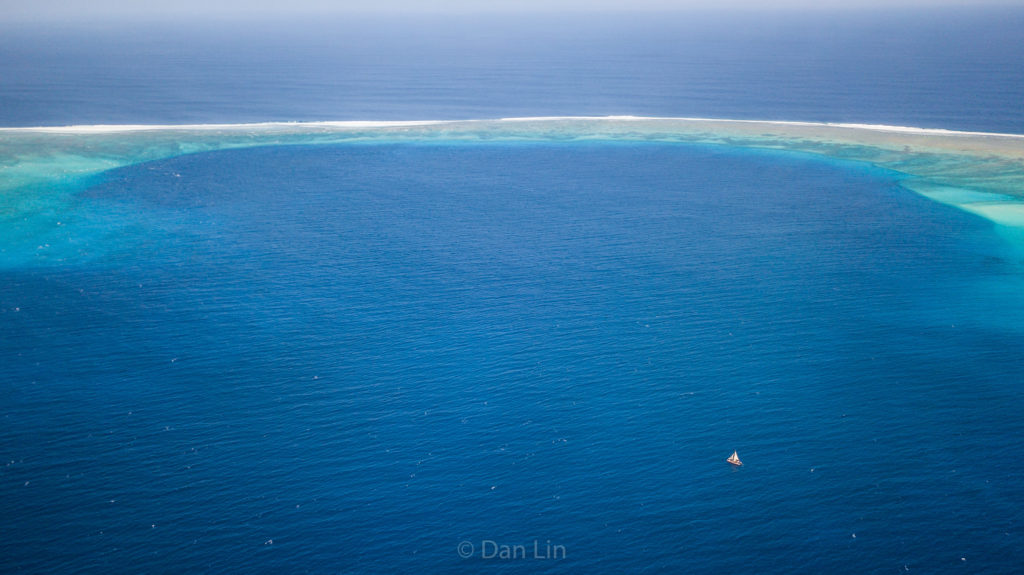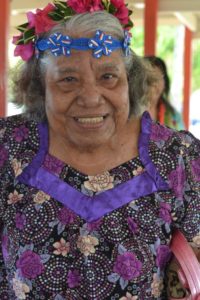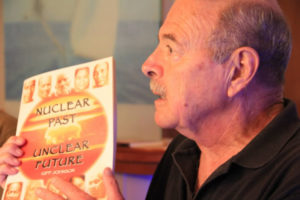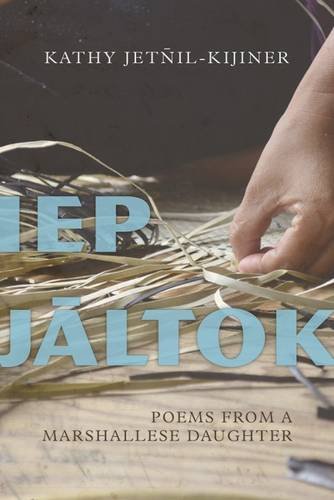What looks like a regular lagoon in the photo above is actually a crater created by the Bravo bomb. And the tiny speck of a canoe is where our crew was seated, looking out at a brilliant blue that was once the site of the largest nuclear blast ever detonated in the world.
This was the last stop of our journey before we returned home to Majuro. It must seem counterintuitive, to start this journey of the #domepoem with our last stop. But I find it fitting on this day, March 1, a day known as Nuclear Victim’s Remembrance Day in the Marshall Islands, to reflect on this visit. Our government chose this date specifically because it coincided with the detonation of Bravo, the largest of 67 nuclear weapons detonated in our islands.
Initially, we weren’t sure we could fit in the visit…we’d heard of the Bravo bomb site but knew it was 3 hours away from the main island of Bikini, where we’d spent the previous night. We weren’t sure there’d be time…we needed to get back to Majuro by the 25th. We debated it as a team. “It’ll just look like regular open water. We won’t be able to see anything without a drone,” one of our team members said.
In the end we decided to go anyways. We sailed from the main atoll of Bikini past the various islets…a smooth ride since we were still in the lagoon – no large waves like on our way to Enewetak. We talked about what we’d do once we got there. Should there be a ceremony? A prayer perhaps? A poem? I had nothing prepared for the moment…I didn’t know we would be stopping there, hadn’t given myself any time to reflect on what it would mean to visit this site that was the source of so much pain and legacies of trauma.
We ended up not performing any ritual because of a decision made by our ri-Bikini team member Edward Maddison. As our elder, and as the only ri-Bikini on the canoe, we listened and respected his wishes.
After taking a wrong turn, we finally ended up at the site. In front of us was a burned out bunker, and to the side was an islet that looked as if it was missing a limb – it had been partially vaporized by the blast. There was greenery, but the island looked stunted with only shrubs and no coconut trees, or any other large trees. We were told there used to be another island next to it. But it had been completely vaporized.
Edward told me later that these two islands were once the “pantry” of a ri-Bikini Irooj or chief. The island that is still alive is called Nam. He wasn’t able to remember the name of the one that disappeared. This meant that they were islands reserved for food for the community. There was more rainfall there so it was lush and plentiful with food. Whenever supplies ran low on the main island that housed most of the ancient Bikinian community, they would sail to these islands for further provisions. These were also the sites of massive breadfruit trees that supplied most of the materials to build their walaps – their large canoes that ri-Bikini and ri-Enewetak were known for.
I haven’t quite grasped what it means to have sat in a canoe 64 years after a bomb blast that incinerated a once existing, thriving island that would have provided materials for ancient canoes.
We sat quietly and waited while the drone took the photo, each lost in our own thought. I had no words to say, nothing poetic came. What I had was a headache. I climbed down into the hull where my bed was and immediately fell asleep.
When we finally reached Majuro, one of the first things I learned was the Limeyo Abon had passed away. Limeyo was 14 years old, and living on Rongelap Atoll the day that the Bravo bomb exploded in Bikini, and radioactive ash was picked up by a tradewind and rained down on her island of Rongelap, onto her family and community. She spent the rest of her life speaking out on the nuclear legacy, traveling the world to tell her story – reliving the day of her trauma, over and over. She did all this as a school teacher, while raising 9 children, 40 grandchildren, and 39 great grandchildren. “What’s important is a place to call home, a place to live freely,” she said in December to Japan Times. “The identity of a Marshallese is gone when you’re moved to another place. In a way, it took away our identity, and that’s what bothers me most.” I had only met her twice…I deeply regret not making time to get know her better.
After I flew out of the Marshalls, on March 1st, only four days after we’d arrived on the canoe, I learned through facebook that Bill Graham had passed away, the former Marshall Islands Nuclear Claims Tribunal Advocate. Limeyo’s family buried her on March 1, and the same day Bill Graham passed away. The fact that he and Limeyo passed away within the week of Nuclear Victim’s Remembrance Day is almost too poetic. Bill was kind and generous with his time, and always sharp and fierce when it came to nuclear issues. He was a walking encyclopedia of nuclear legacy knowledge. He was a former Peace Corp volunteer who came in the 80’s and stayed for the rest of his life. I had just skyped with him in January, before leaving to Enewetak, to get his thoughts on our project for the dome poem.
As I’m sitting here now, I’m wondering how this is all connected – Nuclear Victim’s Day, the Bravo blast, sitting in that canoe in an empty lagoon, the obliterated island, the stunted island, the burnt trees that once fed our ancestors and built canoes, and the deaths of two legacies of nuclear activism. And as usual, I write to understand.
Of Islands and Elders
What happens when islands
that nourished us with the wisdom of their bodies
become barren
amputated –
do they mourn the unfurling greenery
of canoes never birthed?
What happens when islands
are massacred
murdered
and no one remembers
their names?
Do we trick ourselves into believing
they never
existed at all?
And how do we mourn elders
who were islands
lush with knowledge and story?
How do we move forward
without their guidance and wisdom
when we feel barren
amputated?
From inside the hulls
I hear this canoe moan
with sorrow
while waves wail all around me
in fury
Up above
the sails
beating against the wind
whisper
But look –
right there
There exists
still
some
green
Even after
a nuclear blast
life
continues to unfurl
its leaves



